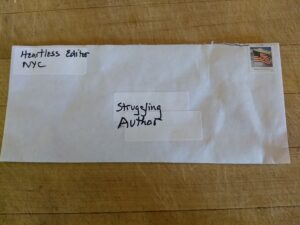Recently, in offline discussion, Joe Hartlaub and I were talking about rejections. He mentioned an editor at Hard Case Crime who wrote the “best” rejections—two to three-page long letters with specific details that proved he paid close attention and had actually read the whole manuscript.
Editors and agents rarely have time to put that much effort into giving feedback to an author. Most often, it’s a quick “Thanks but not for us.”
When a professional reads more than the first five pages of the manuscript and recognizes value in it, the writer is over the moon.
Even though it’s a rejection.
Back in the days when authors submitted manuscripts by snail mail, you always included an SASE (for anyone born after 1980, that’s self-addressed stamped envelope) so the editor/agent could mail rejections to you.
Occasionally, the SASE was used to mail the author a contract or check but that was rare.
There is a hierarchy of rejections–a ladder to climb:
Rung #1 – Unsigned form letter: “This does not meet our needs at this time.”
Rung #2 – Unsigned form letter: “This does not meet our needs at this time but please try us again.”
Rung #3 – Same form letter with a handwritten note (unsigned): “This is good. Do you have anything else?”
Rung #4 – Personal letter: “Good story but too similar to one we recently published. I like your writing. Send more.” Actual editor’s signature.
Rung #5 – Personal letter signed with editor’s first name. Now we’re buddies.
With today’s electronic submissions, the process is similar, just faster and cheaper without the cost of postage and printing.
But the process still requires climbing the rungs.
Finally you clamber onto an exciting but scary roof with a steep pitch. The editor/agent likes the sample chapter and asks for the whole manuscript. Get a toehold on the rain gutter.
A month or five later, the rejection says: “This is good BUT…”
Fill in the blank with:
“Characters felt inconsistent.”
“The climax didn’t live up to expectations.”
“I just didn’t love it enough.”
Etc.
Slide down the roof a bit but hang on with fingernails.
Rewrite and submit more. Inch up the shingles.
“All the editors loved it but the marketing department doesn’t think they can sell it.”
At last, you reach the peak of the roof when you receive a long, detailed, personal letter with specific suggestions.
In December, I received the most beautiful rejection of my entire career (and I’ve received hundreds!). I couldn’t even be unhappy when I read the following:
“Several of us read it and we all enjoyed your fresh, exciting take on a thriller—particularly the way you used the genre to explore the very real issue of elder fraud. There are several striking scenes that are seared in my memory (especially that late-night rescue in the snowstorm!). We thought you developed Tawny and Moe’s relationship with great sensitivity and nuance, and this in turn made Moe’s shifts between lucidity and violence a more emotional experience for readers. Unfortunately, we had difficulty connecting as deeply to Tawny—it often felt like she was kept at a remove from us. For this reason, despite our admiration for your writing and the compelling and dynamic world you’ve created, we don’t think we’re the right publisher for your book. I’m sorry not to have better news. Thank you so much for the opportunity to read and consider STALKING MIDAS, and best wishes in finding the right home for it.”
It felt like the editor had sent me a dozen roses!
When you tell civilians (non-writers) about the wonderful rejection you received, they usually draw their chins back and look down their noses. “You got rejected and you’re happy?”
Only other writers understand the irony of a rave rejection.
What do rejections really mean?
You’re in the game.
What do rave rejections mean?
Publication is in your future.
~~~
TKZers: What is the best rejection you ever received?
Was the story eventually published?
Please check out Debbie Burke’s new thriller Stalking Midas which garnered rave rejections before publication. Here’s the link.





There might be a good blurb or two in that rave rejection!
Eric, you sure know how to find a silver lining! Thanks.
Debbie, you leave me salivating for my first rejection. I’m not far enough along in my author career to have submitted anything to an agent or house, but now I anticipate the experience with all the excitement of my first time behind the wheel of my first car.
Thank you!
Deb, you’re welcome. Great analogy about the first time behind the wheel.
I started with short stories and magazine articles. Rejections are harder with book-length works b/c you’ve invested more time and heart into the project. But by the time I was submitting novels, my calluses were pretty thick. That helped.
Best of luck when you’re ready to take the plunge!
Just before my first professional sale–a 5k confession story back in the olde tyme–an editor, not a confession editor, sent me an actual letter: pretty good piece, Jim. We have one of these scheduled for June. By all means, try us–me–again.
Somewhere in my stuff, I still have that letter. I framed it and hung it on the wall. Every once in awhile, I will look at it.
And cheer.
Jim, I had a similar experience. One encouraging note from an editor can sustain us through years of hard times.
The important lesson is you persisted and got published.
One important thing to remember is that those rungs mean absolutely nothing to the editors. Some send rung 1 to everyone. I had a good friend who had a successful career of over thirty books with Harlequin which was ended with a rung 1 Dear John letter. No follow through. No replies. Nothing. She wasn’t a jerk or unprofessional or anything. Her style had become a bit old-fashioned so they tossed her like garbage.
If an editor leaves, the next editor will often clear off their desk by inserting the standard rejection letter into everything, no matter how far into the process, because she wants to put her own stamp on the books. So, don’t take anything to heart because it’s most often not about you.
Best rejection letters. My first was a handwritten note on the standard rejection which was a love letter to one of my characters, a comic character who thought he was a swashbuckling adventurer but was a good-natured idiot who fell down a lot. Yes, I sold the book, and it’s still in print. Before I wised up and realized that my writing was too quirky for Big Publishing, most of my rejections read like great reviews but ended with “but it doesn’t suit us.”
Marilynn, you make an important point: rejections aren’t personal.
That lesson was driven home to me years ago when I sat on the other side of the desk as editor for small literary journals. I had to turn to down many terrific stories simply b/c they didn’t mesh with the theme of the issue. That was the worst part of the job.
My favorite rejection is my favorite for all the wrong reasons. In 1995, among the 27 agent rejections I collected for NATHAN’S RUN was my own submission letter returned to me in my SASE with a stamp–from one of those rubber things you pound onto an ink pad before pounding it onto the page–that read, “NO.” That was it. No explanation, no nothing. What baffles me is the fact that it takes more effort to stamp a two-letter word than it does to write it!
Wow! That would sting a bit. Glad you went on to prove them wrong.
Ow, John, that’s cold. A friend had a similar experience except the NO stamp was on the outside of the SASE. He couldn’t face the mail carrier for weeks afterward.
My favorite rejections (3 full manuscripts) were from Jenny Bent. She loved my main character, so she kept requesting full manuscripts for three different novels. If it weren’t for her kind, detailed advice, I might never have gotten a handle on characterization. Jessica Faust and Uwe Stender also went the extra mile. I formed friendships with all three after each one rejected me several times. It’s funny how that works, eh? Only one of those old novels sold direct to a publisher (after a rewrite). The other two are trunked, but I’ve stolen scenes here and there. 😀
Sue, advice like that is pure gold. Obviously those pros recognized you were in this for the long haul. More important, you listened to and acted on their wise counsel and went on to success.
BTW, Jessica just confirmed she’ll be the guest agent at our conference in 2020. Excited to have her.
My most mortifying rejection was when I sent an early story to SEVENTEEN Magazine. I’d won a writing contest, and had received a small state fellowship, so I thought I was the shiz! I submitted (without an agent of course) and didn’t hear anything for nine months. Yes, nine months lol. So I CALLED THEM ON THE PHONE and asked about the story. They got back to me via a handwritten card that very kindly said that they didn’t reply if a story wasn’t accepted. Um, it was nine months–I was so naive!
The funniest rejection was from Lee Abbott, an amazing short story writer and head of the Creative Writing program at Ohio State. He graciously said he would work on a few stories with me as a kind of independent study so my husband–also a prof– could stay married to me instead of looking at my work. (I cried every time my poor husband gave me edits.) Lee once returned a story I sent him with a single comment written across the top of the first page: “I don’t know what to do with this.” I just put that story away lol.
Nine months to a year wasn’t that unusual back in the day, esp for little litmags. I recall a few SASEs with rejected submissions that I’d completely forgotten b/c it had taken the magazine so long to respond.
Non-response still bugs me b/c it leaves the writer hanging and wondering. A year ago, an agent immediately responded to my query with great interest…followed by resounding silence. I sent a polite follow-up. More silence. The conclusion: I didn’t want to work with an agent who’s too busy to answer.
Oh–Best rejection came with a four-figure check as a kill fee. : )
Wow, Laura, I wouldn’t mind a few rejections like that!